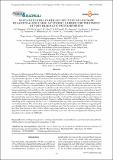| dc.contributor.author | De la Vega, RE | |
| dc.contributor.author | Scheu, M | |
| dc.contributor.author | Brown, LA | |
| dc.contributor.author | Fitzsimons, TJ | |
| dc.contributor.author | Porter, RM | |
| dc.contributor.author | Bajpayee, Ambika Goel | |
| dc.contributor.author | Varady, Nathan H. | |
| dc.contributor.author | Yannatos, I. A. | |
| dc.contributor.author | Krishnan, Yamini | |
| dc.contributor.author | Bhattacharya, Paulomi | |
| dc.contributor.author | Frank, Eliot Henry | |
| dc.contributor.author | Grodzinsky, Alan J | |
| dc.contributor.author | Porter, R. M. | |
| dc.date.accessioned | 2018-09-13T15:58:32Z | |
| dc.date.available | 2018-09-13T15:58:32Z | |
| dc.date.issued | 2017-12 | |
| dc.identifier.issn | 1473-2262 | |
| dc.identifier.uri | http://hdl.handle.net/1721.1/117741 | |
| dc.description.abstract | Disease-modifying osteoarthritis drugs (DMOADs) should reach their intra-tissue target sites at optimal doses for clinical efficacy. The dense, negatively charged matrix of cartilage poses a major hindrance to the transport of potential therapeutics. In this work, electrostatic interactions were utilised to overcome this challenge and enable higher uptake, full-thickness penetration and enhanced retention of dexamethasone (Dex) inside rabbit cartilage. This was accomplished by using the positively charged glycoprotein avidin as nanocarrier, conjugated to Dex by releasable linkers. Therapeutic effects of a single intra-articular injection of low dose avidin-Dex (0.5 mg Dex) were evaluated in rabbits 3 weeks after anterior cruciate ligament transection (ACLT). Immunostaining confirmed that avidin penetrated the full cartilage thickness and was retained for at least 3 weeks. Avidin-Dex suppressed injury-induced joint swelling and catabolic gene expression to a greater extent than free Dex. It also significantly improved the histological score of cell infiltration and morphogenesis within the periarticular synovium. Micro-computed tomography confirmed the reduced incidence and volume of osteophytes following avidin-Dex treatment. However, neither treatment restored the loss of cartilage stiffness following ACLT, suggesting the need for a combinational therapy with a pro-anabolic factor for enhancing matrix biosynthesis. The avidin dose used caused significant glycosaminoglycan (GAG) loss, suggesting the use of higher Dex : avidin ratios in future formulations, such that the delivered avidin dose could be much
less than that shown to affect GAGs. This charge-based delivery system converted cartilage into a drug depot that could also be employed for delivery to nearby synovium, menisci and ligaments, enabling clinical
translation of a variety of DMOADs. | en_US |
| dc.description.sponsorship | National Science Foundation (U.S.) (Grant DMR1419807) | en_US |
| dc.description.sponsorship | National Institutes of Health (U.S.) (Grant EB017755) | en_US |
| dc.description.sponsorship | National Institute of Biomedical Imaging and Bioengineering (U.S.) (Grant EB017755) | en_US |
| dc.description.sponsorship | National Institutes of Health (U.S.) (Grant AR057105) | en_US |
| dc.description.sponsorship | National Institutes of Health (U.S.) (Grant AR060331) | en_US |
| dc.description.sponsorship | National Institute of Arthritis and Musculoskeletal and Skin Diseases (U.S.) (Grant AR057105) | en_US |
| dc.description.sponsorship | National Institute of Arthritis and Musculoskeletal and Skin Diseases (U.S.) (Grant (Grant AR060331) | en_US |
| dc.publisher | ECM Research Journal | en_US |
| dc.relation.isversionof | http://www.ecmjournal.org/papers/vol034/vol034a21.php | en_US |
| dc.rights | Creative Commons Attribution-Noncommercial-Share Alike | en_US |
| dc.rights.uri | http://creativecommons.org/licenses/by-nc-sa/4.0/ | en_US |
| dc.source | European Cells and Materials | en_US |
| dc.title | Sustained intra-cartilage delivery of low dose dexamethasone using a cationic carrier for treatment of post traumatic osteoarthritis | en_US |
| dc.type | Article | en_US |
| dc.identifier.citation | Bajpayee, AG et al. “Sustained Intra-Cartilage Delivery of Low Dose Dexamethasone Using a Cationic Carrier for Treatment of Post Traumatic Osteoarthritis.” European Cells and Materials 34 (December 2017): 341–364 | en_US |
| dc.contributor.department | Massachusetts Institute of Technology. Center for Biomedical Engineering | en_US |
| dc.contributor.department | Massachusetts Institute of Technology. Department of Biological Engineering | en_US |
| dc.contributor.department | Massachusetts Institute of Technology. Department of Electrical Engineering and Computer Science | en_US |
| dc.contributor.department | Massachusetts Institute of Technology. Department of Mechanical Engineering | en_US |
| dc.contributor.mitauthor | Bajpayee, Ambika Goel | |
| dc.contributor.mitauthor | Varady, Nathan H. | |
| dc.contributor.mitauthor | Yannatos, I. A. | |
| dc.contributor.mitauthor | Krishnan, Yamini | |
| dc.contributor.mitauthor | Bhattacharya, Paulomi | |
| dc.contributor.mitauthor | Frank, Eliot Henry | |
| dc.contributor.mitauthor | Grodzinsky, Alan J | |
| dc.contributor.mitauthor | Porter, R. M. | |
| dc.relation.journal | European Cells and Materials | en_US |
| dc.eprint.version | Final published version | en_US |
| dc.type.uri | http://purl.org/eprint/type/JournalArticle | en_US |
| eprint.status | http://purl.org/eprint/status/PeerReviewed | en_US |
| dc.date.updated | 2018-09-06T16:13:20Z | |
| dspace.orderedauthors | Bajpayee, AG; De la Vega, RE; Scheu, M; Varady, NH; Yannatos, IA; Brown, LA; Krishnan, Y; Fitzsimons, TJ; Bhattacharya, P; Frank, EH; Grodzinsky, AJ; Porter, RM | en_US |
| dspace.embargo.terms | N | en_US |
| dc.identifier.orcid | https://orcid.org/0000-0003-4750-7207 | |
| dc.identifier.orcid | https://orcid.org/0000-0001-7880-1391 | |
| dc.identifier.orcid | https://orcid.org/0000-0002-4942-3456 | |
| mit.license | PUBLISHER_CC | en_US |
